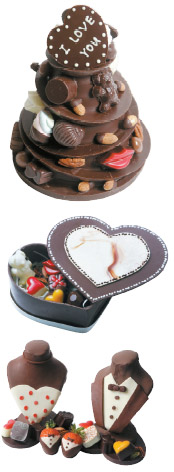A nation’s nascent love affair with the cocoa plant

Buffet decorations at JW Marriott Seoul will include “L’Amour,” the tower of love, top; a heart-shaped chocolate box, middle; and the Honeymoon Marble.
The wife of Karl Weber, the Russian consul general to Korea at that time, is said to have presented Queen Min (1851-1895) with some Western cosmetics and Russian chocolate biscuits. The West had been dabbling in chocolate since the 16th century, when the Spanish began to colonize Aztec lands in South America.
The Korean War was without a doubt a disaster, but if there was a single benefit, perhaps it was the spread of chocolate, courtesy of U.S. soldiers stationed in the country. By 1968, Tongyang Orion group and Haitai group were manufacturing their own brands, and in 1975, Lotte plunged into the burgeoning market.
Chocolate also got a boost during the 1988 Olympics in Korea when an influx of foreigners brought with them an insatiable desire for sport and an unrelenting need for the sweet stuff. Shops filled up with chocolate as Koreans, with more cash to splash than ever before, began buying up tray loads of chocolates for special days like St. Valentine’s Day and birthdays, as Koreans developed chocolates that suited their palates.
“Koreans like chocolates that are less sweet,” says Cha Yae-seok, head of the chain Chocolate Castle. “That’s why I use a Belgian recipe that mixes fruit with cocoa butter. It’s less sweet.”
In addition to a chocolate museum and shop on Jeju Island, off the southern coast of Korea, Cha runs a shop near Changdeok Palace, central Seoul, which displays an array of chocolates designed using local ingredients and traditional Korean designs that you would see in local handicrafts and jewelry. Some are even individually wrapped in bojagi, a colorful hemmed cloth used for wrapping gifts.
Her love affair with sweets dates back 20 years to when she worked at a foreign bank in Korea and went on business trips to Belgium and France. There, she tasted delicacies she could never find back home.
Her specialty these days is mixing ginseng, black sesame, jujube, cactus, tangerine and kiwi with cocoa powder to create a unique flavor that is wholly Korean.
“Just like Belgian, Swiss and German chocolate manufacturers, we import cacao beans,” Cha says, “but we add our own idiosyncratic style to create something special and memorable.”
Divine hot chocolate
Hot chocolate drinks are relative newcomers to local cafes and bars compared to the centuries-old love affair with the invigorating sweet beverage, but its short history in no way diminishes its popularity. In fact, a number of cafes dedicated solely to chocolate have sprouted around the capital in recent years, one of which is Chocolat Yum (02-337-1027) in Hongdae, northern Seoul.
“Koreans like the smooth, pure, creamy flavor,” says the cafe’s owner Kim Yoo-mi, adding that cacao beans create “a divine drink that fights fatigue.”
These cafes convey an artsy image that contrasts strongly with traditional tea shops and sleek, corporate cafe franchises. “I call my cafe a chocolate gallery. I’m an artist who makes chocolates,” she says.
Chocolat Yum is not the only one. The interior of De Chocolate Coffee (02-514-7101), a franchise with offshoots in Hakdong, Apgujeong and Seorae Village, all in southern Seoul, and Ilsan in Gyeonggi, is also a bohemian’s refuge for a quiet chocolate daydream.
With Valentine’s Day coming next week, Cacao Boom (02-3141-4663) is stocking 63 different kinds of chocolates instead of the usual 20 that they serve, according to Koh Young-joo, one of the cafe’s chocolatiers. “It’s human instinct to crave something sweet,” Koh said. “The sensational taste of well-made, handcrafted chocolates is as soft as silk.”
By Lee Eun-joo Staff Reporter [angie@joongang.co.kr]










with the Korea JoongAng Daily
To write comments, please log in to one of the accounts.
Standards Board Policy (0/250자)